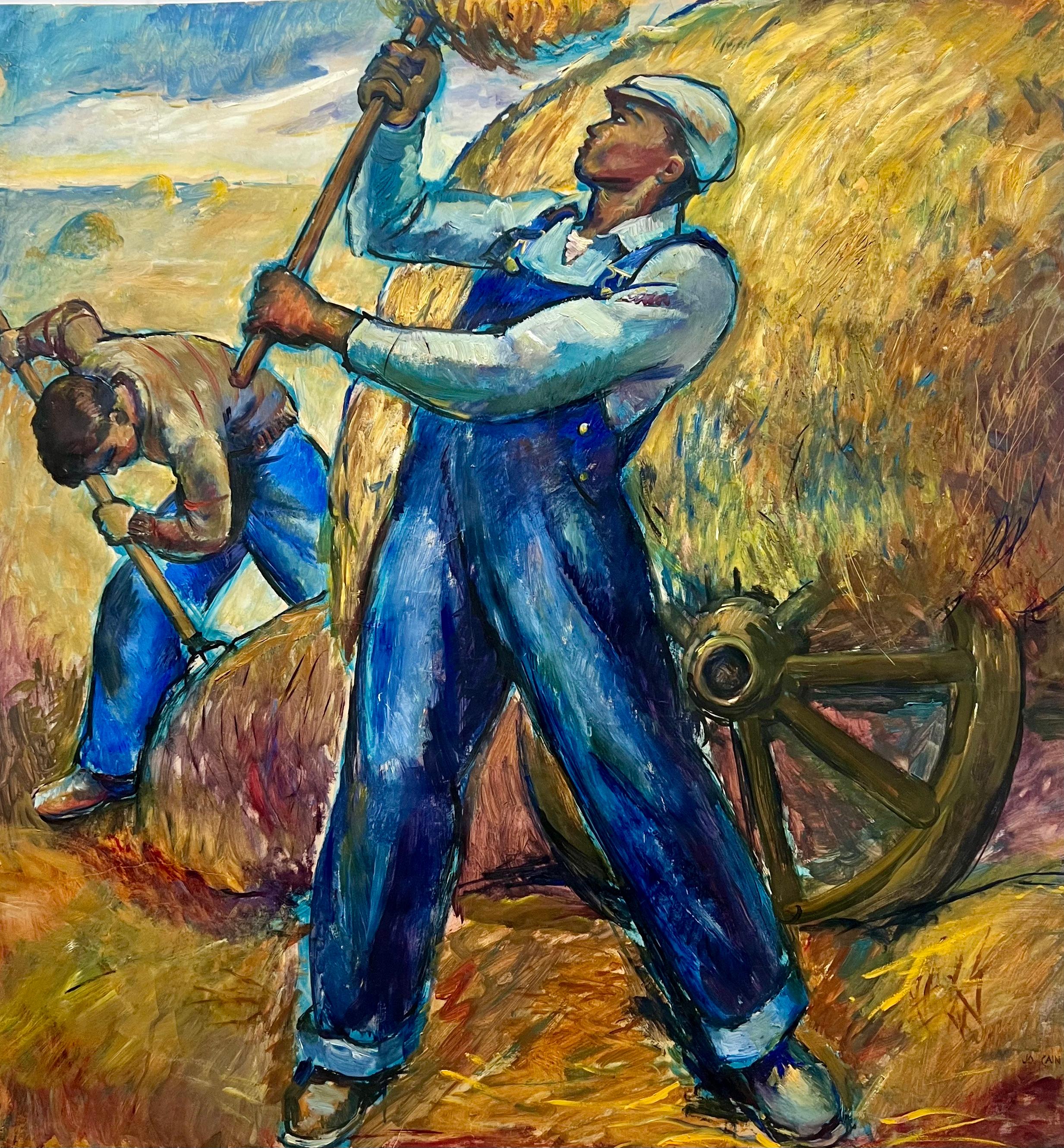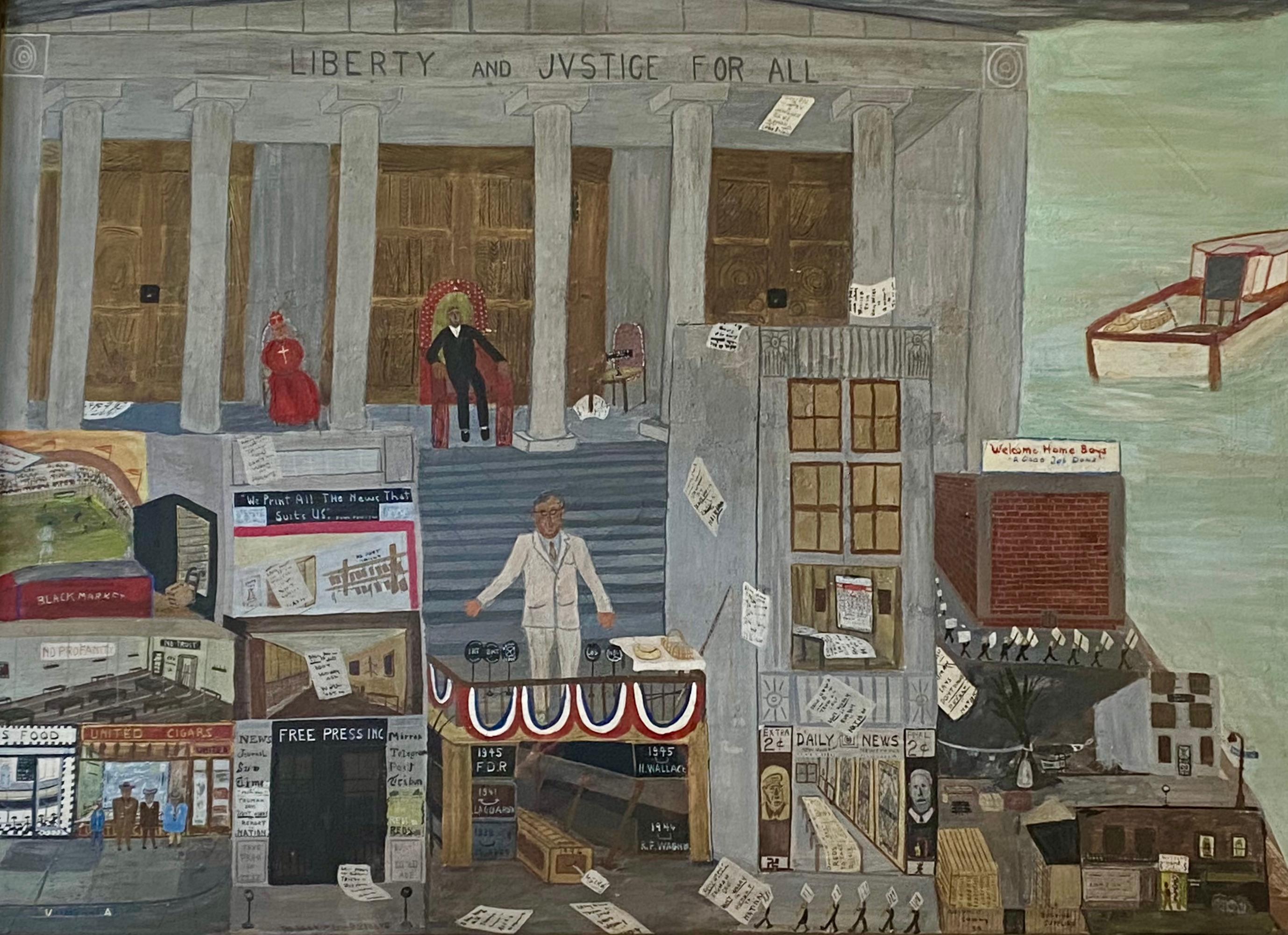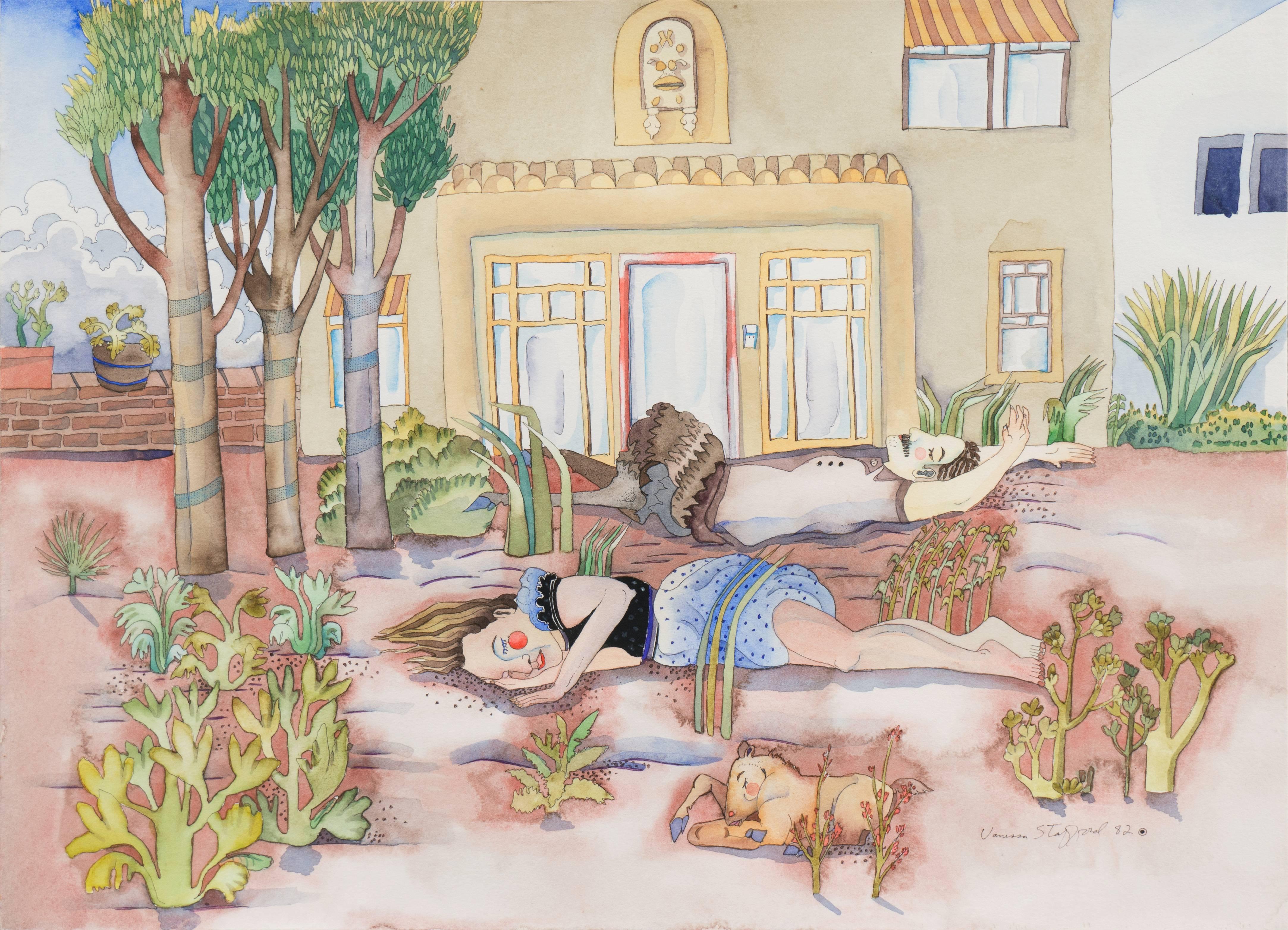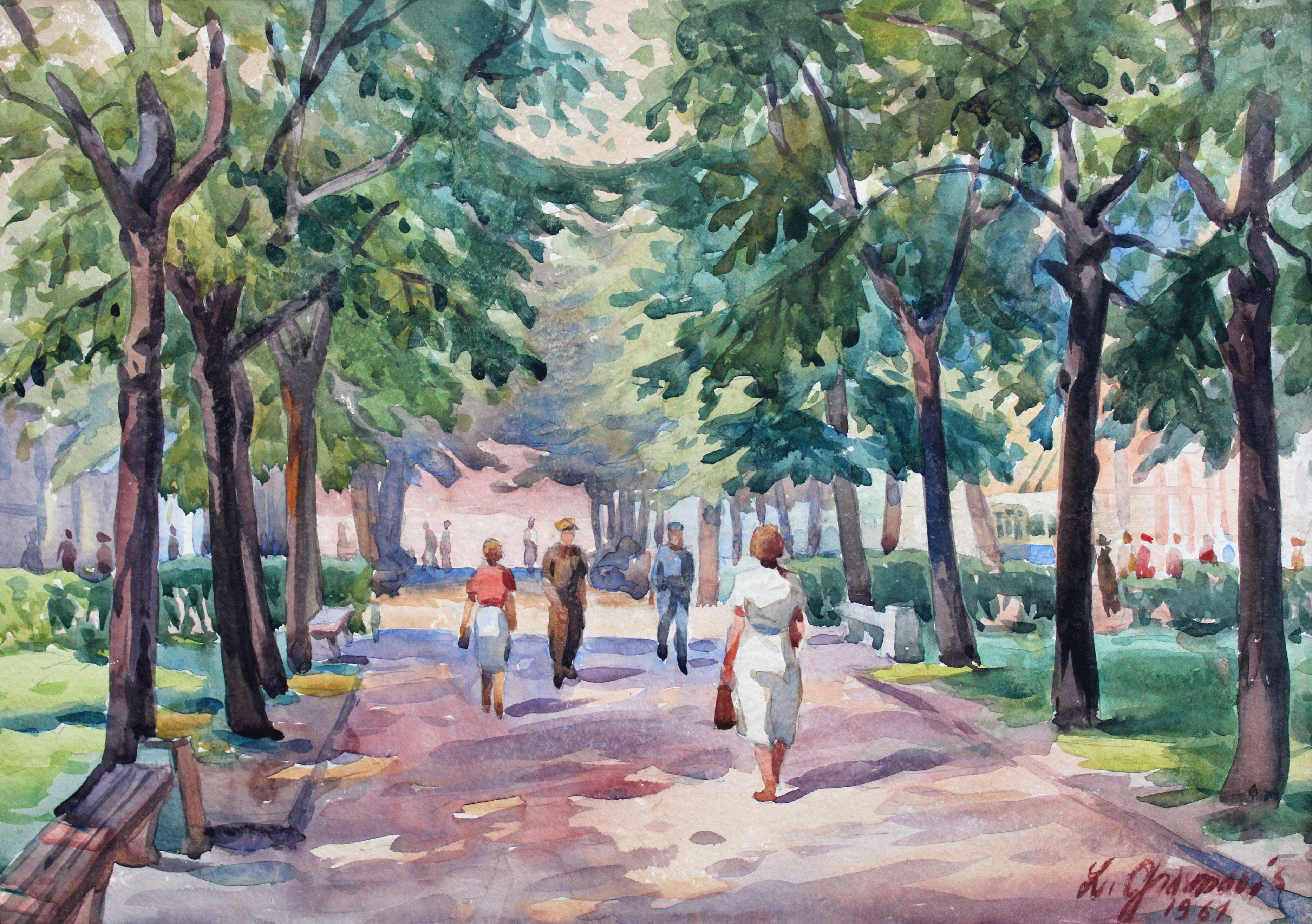Items Similar to "Lobstermen in Gloucester, Mass." Lionel Reiss WPA Social Realism Fishermen
Want more images or videos?
Request additional images or videos from the seller
1 of 9
Lionel S. Reiss"Lobstermen in Gloucester, Mass." Lionel Reiss WPA Social Realism Fishermencirca 1943
circa 1943
About the Item
Lionel S. Reiss (1894 - 1988)
Lobstermen in Gloucester, Massachusetts, circa 1943
Watercolor on paper
Sight 17 1/2 x 23 inches
Signed lower left
Provenance:
Private Collection, Las Vegas, Nevada
In describing his own style, Lionel Reiss wrote, “By nature, inclination, and training, I have long since recognized the fact that...I belong to the category of those who can only gladly affirm the reality of the world I live in.” Reiss’s subject matter was wide-ranging, including gritty New York scenes, landscapes of bucolic Bucks County, Pennsylvania, and seascapes around Gloucester, Massachusetts. However, it was as a painter of Jewish life—both in Israel and in Europe before World War II—that Reiss excelled. I.B. Singer, the Nobel Prize winner for Literature, noted that Reiss was “essentially an artist of the nineteenth century, and because of this he had the power and the courage to tell visually the story of a people.”
Although Reiss was born in Jaroslaw, Poland, his family immigrated to the United States in 1898 when he was four years old. Reiss's family settled on New York City’s Lower East Side and he lived in the city for most of his life. Reiss attended the Art Students League and then worked as a commercial artist for newspapers and publishers. As art director for Metro-Goldwyn-Mayer, he supposedly created the studio’s famous lion logo.
After World War I, Reiss became fascinated with Jewish life in the ‘Old World.’ In 1921 he left his advertising work and spent the next ten years traveling in Europe, the Middle East, and North Africa. Like noted Jewish photographers Alter Kacyzne and Roman Vishniac, Reiss depicted Jewish life in Poland prior to World War II. He later wrote, “My trip encompassed three main objectives: to make ethnic studies of Jewish types wherever I traveled; to paint and draw Jewish life, as I saw it and felt it, in all aspects; and to round out my work in Israel.”
In Europe, Reiss recorded quotidian scenes in a variety of media and different settings such as Paris, Amsterdam, the Venice ghetto, the Jewish cemetery in Prague, and an array of shops, synagogues, streets, and marketplaces in the Jewish quarters of Warsaw, Lodz, Krakow, Lublin, Vilna, Ternopil, and Kovno. He paid great attention to details of dress, hair, and facial features, and his work became noted for its descriptive quality.
A selection of Reiss’s portraits appeared in 1938 in his book My Models Were Jews. In this book, published on the eve of the Holocaust, Reiss argued that there was “no such thing as a ‘Jewish race’.” Instead, he claimed that the Jewish people were a cultural group with a great deal of diversity within and between Jewish communities around the world. Franz Boas, the founder of modern anthropology, contributed the introduction to the book to support Reiss’s view. Unfortunately, the Nazis thought otherwise and initiated a policy of genocide against the Jewish ‘race’ that ultimately murdered 6 million Jews. After World War II, Reiss wrote, “Doubtless most of my models in Central and Eastern Europe were numbered among the millions of victims. They have haunted me for years.”
Reiss had first observed life in Israel in 1930-31 under the British mandate. In 1952, the Jewish Reconstructionist movement gave Reiss a grant that allowed him to devote six months to traveling through Israel and depicting what he saw. In Israel, he gushed, “there is a lifetime of possibilities in the inexhaustible themes.” In 1954, Reiss published his second book, New Lights and Old Shadows. It contained 210 paintings, watercolors, drawings, and etchings that dealt with “the new lights” of a reborn Israel and the “old shadows” of a European Jewish culture that had been almost wiped out. Reiss reprised the same theme in his last book, A World of Twilight [1972]. He continued painting almost until his death.
Lionel Reiss’s strong Jewish identity and his premonition that European Jewish life itself was in danger of vanishing helped him create a record of that culture. “It was my hope,” he later wrote, “that by pencil and brush I might perpetuate many of the visual aspects of a people whose patterns of life were rapidly changing, and whose memorable landmarks were vanishing.” Thanks to his work, the faces, ghetto architecture, synagogues, and alleyways all remain to remind the viewer of a time and place that no longer exist.
- Creator:Lionel S. Reiss (1894-1988, American)
- Creation Year:circa 1943
- Dimensions:Height: 29 in (73.66 cm)Width: 33.5 in (85.09 cm)
- Medium:
- Movement & Style:
- Period:
- Condition:
- Gallery Location:New York, NY
- Reference Number:1stDibs: LU184129905762
About the Seller
5.0
Platinum Seller
These expertly vetted sellers are 1stDibs' most experienced sellers and are rated highest by our customers.
Established in 2021
1stDibs seller since 2022
63 sales on 1stDibs
Typical response time: <1 hour
- ShippingRetrieving quote...Ships From: Larchmont, NY
- Return PolicyA return for this item may be initiated within 3 days of delivery.
More From This SellerView All
- "Sleigh Ride, Winter, " Fletcher Martin, Woodstock, Holiday Scene IllustrationBy Fletcher MartinLocated in New York, NYFletcher Martin (1904 - 1979) Sleigh Ride, Woodstock, New York circa 1955 Watercolor on paper 14 x 11 inches Signed lower right Provenance: James Cox Galler...Category
1950s American Realist Landscape Drawings and Watercolors
MaterialsPaper, Watercolor
- "The Red Silo" Winold Reiss, Rural Regionalist Landscape, Sunny Day on FarmBy Winold ReissLocated in New York, NYWinold Reiss The Red Silo Signed lower left Watercolor on paper 20 x 29 inches Winold Reiss (1886-1953) was an artist and designer who emigrated to the United States from Germany in 1913. Probably best known as a portraitist, Reiss was a pioneer of modernism and well known for his brilliant work in graphic and interior design. A compassionate man who greatly respected all people as human beings, he believed that his art could help break down racial prejudices. Like his father Fritz Reiss (1857-1915), who was also an artist and who was his son's first teacher, Winold Reiss was artistically moved by diverse cultures. The elder Reiss focused on folk life in Germany while Winold drew substantial inspiration from a range of cultures, particularly Native American, Mexican, and African-American. As did many young aspiring artists, Winold Reiss studied with the esteemed painter and teacher Franz von Stuck at the Royal Academy of Fine Arts in Munich, which was at that time a center of the decorative and fine-arts movement. It is not known whether Reiss met E. Martin Hennings...Category
Mid-20th Century American Realist Landscape Drawings and Watercolors
MaterialsPaper, Watercolor
- "Afternoon Sun, " Ann Wyeth McCoy, Interior and LandscapeLocated in New York, NYAnn Wyeth McCoy (1915 - 2005) Afternoon Sun Watercolor on paper Sheet 24 x 18 inches Signed lower left Provenance: Somerville Manning Gallery Private ...Category
20th Century American Realist Landscape Drawings and Watercolors
MaterialsWatercolor, Paper
- "In Foreign Parts" Eugene Higgins, Southwestern Pueblo, Modern FigurativeBy Eugene HigginsLocated in New York, NYEugene Higgins In Foreign Parts, circa 1913 Signed lower right Watercolor on paper Sight 17 x 13 inches Born William Victor Higgins in 1884 to a Shelbyville, Indiana farm family where the only art Victor was aware of as a child was his father's love of flowers. "He loved their forms and their colors, and he tended his garden as a painter might work a canvas." At the age of nine, Victor met a young artist who traveled the Indiana countryside painting advertisements on the sides of barns. He purchased paints and brushes so the young Higgins could practice his own artwork on the inside of his father's barn. He also taught Victor about art museums and especially about the new Chicago Art Institute. This information never left the young artist, and he saved his allowance until his father allowed him at the age of fifteen to attend Chicago Art Institute. He worked a variety of jobs to finance his studies both there and at the Academy of Fine Arts. Victor Higgins traveled to New York in 1908, where he met Robert Henri, who became a significant influence by depicting every-day scenes and stressing the importance of the spirit and sense of place as important factors in painting. Higgins was also greatly affected by the New York Armory Modernism Show of Marsden Hartley in 1913. While Victor Higgins was in Chicago he met former mayor and avid collector Carter H. Harrison who was to prove instrumental in the growth of Higgins career for several years. Harrison agreed to support Higgins for four years to go to Paris and Munich and paint and study in the great museums in Europe. While at the Academie de la Grande Chaumier in Paris (1910-1914) he met Walter Ufer, who was another Chicago artist being sponsored by Carter Harrison. This meeting was not only a life-long friendship, but the beginning of a great change in the way Higgins looked at "American" art. He decided that America needed it's own authentic style rather than the 19th Century classic style he was taught in Europe. Very soon after returning to Chicago in 1914, Harrison sent him and Walter Ufer on a painting trip to Taos, New Mexico for a year in exchange for paintings. Higgins made other similar agreements and was able to support himself with his painting. This trip was a life-changing experience and introduced Higgins to the authentic America he had been looking for. In 1914 Taos was an isolated village about twelve hours from Santa Fe on an impossible dirt road. But the colorful life of the pueblo people and the natural beauty drew a collection of artists who became the Taos art colony, from which the Taos Society of Artists was founded in 1915. Victor Higgins became a permanent resident within a year of his arrival and a member of the society in 1917, exhibiting with Jane Peterson in 1925 and with Wayman Adams and Janet Scudder in 1927. The members would travel around the country introducing the Southwest scenes with great success. He remained a member until the Society's dissolution in 1927. Higgins was the youngest member of the group of seven. Other members were Joseph Henry Sharp, Bert Phillips...Category
1910s American Modern Figurative Drawings and Watercolors
MaterialsWatercolor, Paper
- "Portrait of an Italian Fencer, " John Frederick Kensett, Hudson River SchoolBy John Frederick KensettLocated in New York, NYJohn Frederick Kensett (1816 - 1872) Portrait of an Italian Fencer, circa 1845-47 Watercolor on wove paper 13 1/8 x 8 1/8 inches Signed with initials and inscribed lower right "J.F.K. Rome" From October 1845 through the spring of 1847, Kensett lived in Rome. He attended classes where he sketched from live models, and he sketched in the countryside outside Rome and around Florence, Perugia, and Venice, places he visited with his artist friends. He fulfilled commissions for paintings from Americans in Italy, and by 1847 his career was well established. Son of an English immigrant engraver, John Kensett lacked enthusiasm for that medium and became one of the most accomplished painters of the second generation of Hudson River School painters. His reputation is for Luminism, careful depiction of light, weather, and atmosphere as they affect color and texture of natural forms. He was particularly influenced by the painting of Asher Durand in that he focused on realism and detail rather than the highly dramatic views associated with Thomas Cole. Going to the western United States in the mid 1850s and the 1860s, he was the first of the Hudson River School painters to explore and paint the West. Kensett was born and raised in Cheshire, Connecticut, and learned his engraving from his father, Thomas Kensett with whom he worked in New Haven, Connecticut until 1829. He continued working until 1840 as an engraver of labels, banknotes and maps and was employed part of that time by the American Bank Note Company in New York City. There he met Thomas Rossiter, John Casilear, and other artists who urged him to pursue painting. In 1840, he and Rossiter, Asher Durand, and Casilear went to Europe where Kensett stayed for seven years and supported himself by doing engraving but became accomplished in landscape painting. Having sent canvases of Italian landscapes back to New York, he had a reputation for skillful painting that preceded him. When he returned to New York City in 1847, he was an "instant success" and very sought after by collectors. Two of his Italian landscapes had already been purchased by the American Art Union. By 1849, he was a full member of the National Academy of Design and was generally popular among his peers. His studio was a gathering place with travelers stopping by to see his canvases and to identify "precise locations in the Catskills or Newport or New England in the oil sketches and drawings that covered his walls." (Zellman 170). For the women, he was a popular bachelor, "romantic looking with high forehead and sensitive expression." (Samuels 262) He was also sought after by many organizations. Among his activities were serving on the committee to oversee the decoration of the United States Capitol in Washington DC, and becoming one of the founders of the Metropolitan Museum in New York. An inveterate traveler, Kensett spent summers on painting excursions away from New York City. One of these trips was a special painting excursion with fifteen other artists sponsored by the B & O Railroad from Baltimore, Maryland to Wheeling, West Virginia. Unlike many of the Hudson River painters...Category
1840s Hudson River School Figurative Paintings
MaterialsWatercolor, Paper
- "Untitled" Bob Thompson, Figurative Work on Paper, Black Abstract ArtistBy Bob ThompsonLocated in New York, NYBob Thompson Untitled, 1964 Felt tip pen on printed paper 11 x 20 1/2 inches Provenance: The artist Kathy Komaroff Goodman (gift from the artist) Hollis Taggart, New York Exhibited...Category
1960s Modern Figurative Drawings and Watercolors
MaterialsWatercolor, Paper
You May Also Like
- WPA Mid 20th Century Modern Social Realism American Scene Men Working IndustrialBy Jo CainLocated in New York, NYWPA Mid 20th Century Modern Social Realism American Scene Men Working Industrial Jo Cain (1904 - 2003) Bailing Hay 42 x 40 inches Oil on paper c. 1930s Signed lower right Unframed Our gallery is pleased to present the exhibition, "Jo Cain: Echoes of an Era," a tribute to the enduring legacy of Joseph Lambert Cain and a celebration of his art that transcends time and remains relevant today. The exhibition features mural studies, works on paper and paintings from the 1930s and 40s, all are available on 1stDibs. BIO JOSEPH LAMBERT CAIN (1904–2003) A painter, muralist, and art educator, Joseph Cain...Category
1930s American Realist Figurative Drawings and Watercolors
MaterialsPaper, Oil
- Outsider Folk Art American Mid-Century Naive WW2 Self Taught WPA Depression EraBy Ralph FasanellaLocated in New York, NYOutsider Folk Art American Mid-Century Naive WW2 Self Taught WPA Depression Era "Victory for Now" Ralph Fasanella (1914-_1997) "Victory and After,” gouache on paper. Signed, titled...Category
1940s Outsider Art Landscape Paintings
MaterialsGouache, Paper
- Fishing Boats Along The CoastLocated in Soquel, CAFishing Boats Along The Coast Watercolor painting depicting two fishing boats and fishermen along the oceanside by Robert Wayne Daley (American, 1922-1999). Rocks make up a pathway along the beach, while fishermen pull boats along the shore. Blue skies, with the ocean and hilltops making up the near distance. Signed "Robert W Daley...Category
Late 20th Century American Impressionist Figurative Drawings and Waterco...
MaterialsWatercolor, Paper
- 'After the Bacchanal', Contemporary Bay Area figuralBy Vanessa StaffordLocated in Santa Cruz, CASigned lower right, 'Vanessa Stafford' (American, born 1954) and dated 1982. Vanessa Stafford received her Bachelor of Science in Graphic Design from San Jose State University. She ...Category
1980s Modern Landscape Paintings
MaterialsPaper, Watercolor, Pen
- 'Garden Landscape with River', 19th Century Kano SchoolLocated in Santa Cruz, CAA finely-drawn Kano School watercolor and gouache showing figures in kimonos on a bridge and seated beside a stylized river flowing through a graceful garden. An elegantly formal com...Category
Late 19th Century Landscape Paintings
MaterialsGold Leaf
- Boulevard at summer. 1961, paper, watercolor, 37x52 cmLocated in Riga, LVBoulevard. 1961, paper, watercolor, 37x52 cm Laimdonis Grasmanis (1916-1970) 1933 – 1937 – Art school of Applied art in Liepaja 1937 – 1942 – Art Academy of Latvia Artist took pa...Category
1960s Realist Landscape Paintings
MaterialsPaper, Watercolor





